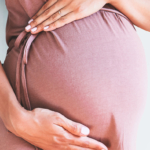Ms. P is a 32-year-old married woman who presented for consultation regarding the use of medication during pregnancy. She had been taking fluoxetine (Prozac) 20 mg for many years for the treatment of recurrent major depression and generalized anxiety. In addition, she was prescribed gabapentin (Neurontin) for sleep.
During the consultation, we reviewed the risks and benefits of using fluoxetine during pregnancy. Prior to this visit, Ms. P had tried several times to gradually come off the fluoxetine but had experienced recurrent anxiety. Given the well-characterized reproductive safety profile of fluoxetine, Ms. P decided that she would prefer to continue on this medication during the course of her pregnancy.
The discussion regarding the use of gabapentin was more complicated. Without it, Ms. P reported difficulty falling asleep and worse anxiety. Data regarding the reproductive safety of gabapentin is limited. A recent study included 59 infants exposed to gabapentin; one (1.7%) was noted to have a major malformation. This study lacks sufficient data to meaningfully assess the reproductive safety of gabapentin. It is estimated that at least 400 to 600 exposures would be required to detect a 2-fold increase in more common malformations. In general, we try to avoid the use of gabapentin during pregnancy, as there are other alternatives that are better characterized for use during pregnancy.
We discussed several other options for managing her sleep and residual anxiety:
1. Cognitive-behavioral therapy may be useful for managing residual anxiety and sleep disturbance and may help to minimize exposure to medication.
2. She might benefit from an increased dose of fluoxetine to manage her residual anxiety and depression and allow her to discontinue gabapentin.
3. She might consider adding a tricyclic antidepressant. Cumulative data suggest no increase in risk of malformation with this class of medications.
4. She might consider treatment with a benzodiazepine. Although initial reports suggested that there may be an increased risk of cleft lip and cleft palate, more recent reports have shown no association between exposure to benzodiazepines and risk for cleft lip or palate. Pooling the data suggests that this risk– if it exists — is estimated to be 0.7%.
5. Another option might be a sedative-hypnotic agent, such as zolpidem, although this class of medication is not as well-characterized as the options listed above.
Ruta Nonacs, MD PhD
Mølgaard-Nielsen D, Hviid A. Newer-generation antiepileptic drugs and the risk of major birth defects. JAMA 2011;305(19):1996-2002.








If she is not suicidal and does not have suicide attempts, I would take her off all medication and hospitalize her for short duration whenever her symptoms become overwhelming.
Diphenhydramine (Benadryl) and Doxylamine (Unisom) are also low-risk options for a sleeping medicine in pregnancy.
yes – interesting and helpful. Would you also consider using trazodone for sleep?
thanks
@Miriam Schechter MD, Some women do use Trazodone during pregnancy; however, there is less information regarding its safety than some of the other medications discussed here:
http://womensmentalhealth.org/library/psychiatric-disorders-during-pregnancy/editors-comments-the-use-of-nefazodone-and-trazodone-during-pregnancy/
If she is doing well on Prozac she should continue taking it, rather than risk a relapse. The recommendations for an alternative to Neurontin seem appropriate.
I wish more providers utilized the information from this website when treating women who are, and who wish to become pregnant. I was disappointed to read a blog on Boston.com about a woman who was told she had to choose between her health and her baby’s health. She subsequently stopped taking Zoloft prior to getting pregnant and resumed in post-partum, though stated that she was unable to breastfeed as a result.
Ultimately, each woman must decide what the best course of action is, in consultation with care providers. Care providers should remember that untreated mood disorders are not innocuous. Certain drugs may show a very small association with certain birth defects, but this does not necessarily mean that the best course of action is always for the woman to discontinue any and all psychotropic drugs. Women who carefully consider the risks and choose to continue taking a psychotropic medication during pregnancy or while breastfeeding should not feel that doing so is inappropriate.
@MBinMA, Thank you for your thoughtful comments.
@sushil rao,
Hi Dr Rao,
I would respectfully disagree on stopping the fluoxetine. I would discuss overall risk and the possible class effect if the information on Paxil and heart defects is correct. What may result is paranoia over the medication for an overall low, if any risk for the developing fetus.
There is no reason to be more afraid of the Prozac than a relapse but I would give the choice to the patient. Perhaps even a lower dose if she has been stable or stopping if that is her choice.
It depends on the orientation I suppose, but if you stop the drug, the patients cognitive processes may prevent reinitation or guilt if they do reinitiate.
Regards and Merry Christmas
Hello. I am 23 wks pregnant and ive been taking gabapentin since before i found out i was pregnant. My Doctor has me on 1800mg a day they are 600mg 3 times a day. I am extremely worried about taking this medicine but my doctor recommended me to stay on aslo i am on celexa i take about 20mg a day. Does anyone have any info on this or any past experiences with gabpentin pregnant? please help. thanks
@Liz, can I ask how your baby is? I have found out I’m pregnant and take gabapentin for my chronic nerve pain. I’m worried about its affects. Thank you, and I hope you and your baby are doing well.
I took gabeapentin b4 I knew I was preggo, please Liz let me know how your baby is, yours to Jen
Iv just found out I’m pregnant 7 weeks and on gabapentin can anyone advise whether I should stay on it or not? Thanks
Unfortunately we can’t really advise you on what you should do, but you should certainly discuss this with your own physician.